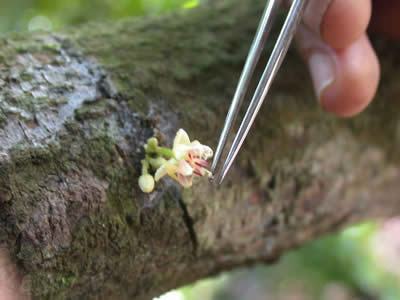Populations | Donate | Distribution | Genomics | Flavour | Screening
Enhancement
Germplasm enhancement commenced at the Cocoa Research Centre (CRC) in 1997 with pre-breeding for Black Pod (BP) disease resistance. Progeny from 96 crosses generated from ICG,T accessions resistant to BP disease and with good agronomic characters such as low pod index, large bean size and high bean numbers, were screened by the leaf disc technique (Nyassé et al., 1995) for resistance to BP disease. The resistant progeny (F1) were planted in the field.
In a second cycle which was initiated in 2004 and sponsored by the CFC/ICCO/BI Cocoa Project, 24 crosses were generated from F1 progeny showing resistance to BP disease. Resistance was confirmed by screening using the pod spraying inoculation technique. F1 progeny were also crossed with Trinidad Selected Hybrids (TSH) in a collaborative project with the Ministry of Food Production, Land and Marine Affairs (Government of the Republic of Trinidad and Tobago) to improve resistance to BP disease in the TSH accessions.
The resulting seedlings were assessed for BP disease resistance using a leaf punch method (Iwaro, 1995).
In 2004 CFC/ICCO/BI Cocoa Project also sponsored germplasm enhancement work on combined resistance to Witches' Broom (WB) and BP diseases. Five thousand, three hundred seedlings produced from 58 crosses were screened for WB disease resistance using the agar droplet inoculation method (Surujdeo-Maharaj et al., 2003).
One thousand, two hundred and fifty progeny showed moderate to high WB disease resistance and were screened for BP disease resistance using the leaf disc technique (Nyassé et al., 1995). All crosses showing resistance to both diseases were planted in the field together with a few susceptible to the aforementioned diseases for future field observation.

More on Genetic Resources Management
Populations | Donate | Enhancement | Distribution | Genomics | Flavour | Screening

















